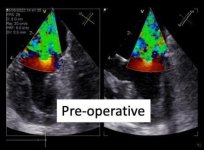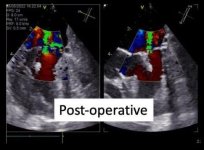As far as I know, that Tufts research has been shut down -- an absolute failure. Interestingly, CavalierHealth.org predicted this failure back in 2017. See
https://cavalierhealth.org/blog.htm#June_17,_2017 ("American Cavalier King Charles Spaniel Club’s Charitable Trust falls for the impossible promised dream").
As for what is "significant" enlargement, this is what CavalierHealth.org means by that:
First of all, you have to know what your dog's normal-sized left atrium and/or left ventricle was before the onset of any enlargement. The left atrium (LA) is measured by echocardiogram both as a linear dimension of its width, taken at a specific point in the heart beat cycle (called the left atrium dimension -- LAD) and as a ratio of the LAD and the Aorta dimension (Ao). This is called the LA:Ao or the LA/Ao ratio, and it is used most often by cardiologists when deciding if the left atrium is or is not enlarged.
The left ventricle dimension is measured both using the linear width at a precise point in the cycle and also with this complex calculation called the LVIDdN, which involves both the weight of the dog and an exponent.
Enlargement also can be determined by x-rays. If you compare an x-ray of the heart taken when you know there was no enlargement (a "baseline"), and you compare it to an x-ray taken when you know there has been some enlargement, you can compare the sizes of the heart using a method called the Vertebral Heart Size (VHS).
As an example using the echo measurement of the left atrium (LA), let us say that the LA:Ao ratio when the dog had a normal sized heart was 1.1. This would be typical for a cavalier, which as a breed has a range of normal LA:Ao ratios from around 0.47 to 1.36. That is a wide range for one breed, which shows how unhelpful it is to rely upon even a breed-specific reference range when you are trying to figure out what it is for just one cavalier.
So, if the dog's normal LA was an LA:Ao of 1.1, and then a year or so later, after the dog has been diagnosed with a mitral murmur, the next echo scan showed a LA:Ao of 1.25, that tells you that the left atrium has begun to enlarge. But, is it "significant enlargement"? Probably not. I would not start pimobendan at that point, even though we know that enlargement has begun. Why not?
Well, there are at least a couple of reasons. First, we know from published research that pimobendan can cause some bad "adverse reactions" in some dogs, and especially when the drug is given to dogs with healthy hearts or too soon in the enlargement cycle. Those adverse reactions have been known to include acceleration of the MVD's progression, and even sudden death. As you pointed out, in the EPIC Study, 8.5% of the dogs in the pimobendan group (as opposed to the placebo group) died of sudden cardiac arrest before any of them reached heart failure.
Another reason for waiting to start the pimobendan is a lesson in the EPIC Study itself. About 45% of all of the dogs in the EPIC Study were cavaliers. It is unfortunate that the investigators have refused to single out the CKCS data in that EPIC Study and report on our breed alone. I asked Dr. Boswood, the lead investigator in EPIC, to do that, and he told me no. Suffice it to say he can be a real jerk.
So what do we learn from the EPIC Study about when to start pimobendan? Well, before they started to accumulate their data from the dogs in that study, those investigators arbitrarily defined an enlarged left atrium as having a LA:Ao ratio of 1,6 or higher. (I say "arbitrarily" because none of that definition was based upon any published evidence of cut-offs between normal and enlarged on a species-wide basis., and at least 31 published articles have insisted that at the very least, breed-specific cut-offs should be used when determining if a dog has an enlarged heart or not.)
What this meant in so far as the cavaliers in the study were concerned is that they all had not only enlarged left atria, but they had
significantly enlarged left atria. The cut off for normal sized left atria in CKCSs is about 1.36, and 1.6 is significantly larger than that.
Now, one thing Dr. Boswood told me about the 8.5% of dogs in the pimobendan group that died of cardiac arrest is that 4% (or half) were cavaliers. We don't know why they died, because the investigators refused to do post-mortems on any of them, but we know from prior research that some dogs reacted very badly to pimobendan when started too early. Also, I spoke with another cardiologist who was one of the investigators in the EPIC Study about those dead dogs. This guy is probably the top veterinary cardiologist in the world. Dr. Boswood pales before him. This cardiologlist (who shall remain un-named) said they probably died of atrial fibrillation, very likely due to the effects of the drug. He said that because of the suddeness of their deaths.
So, my bottom line for defining "significant enlargement" is, in the context of the left atrium (leaving the left ventricle and the Vertebral Heart Size -- VHS for another day), for a cavalier with a normal LA:Ao of 1.1, a significantly enlarged LA:Ao in the range of 1.6 and certainly not as low as 1.25.



